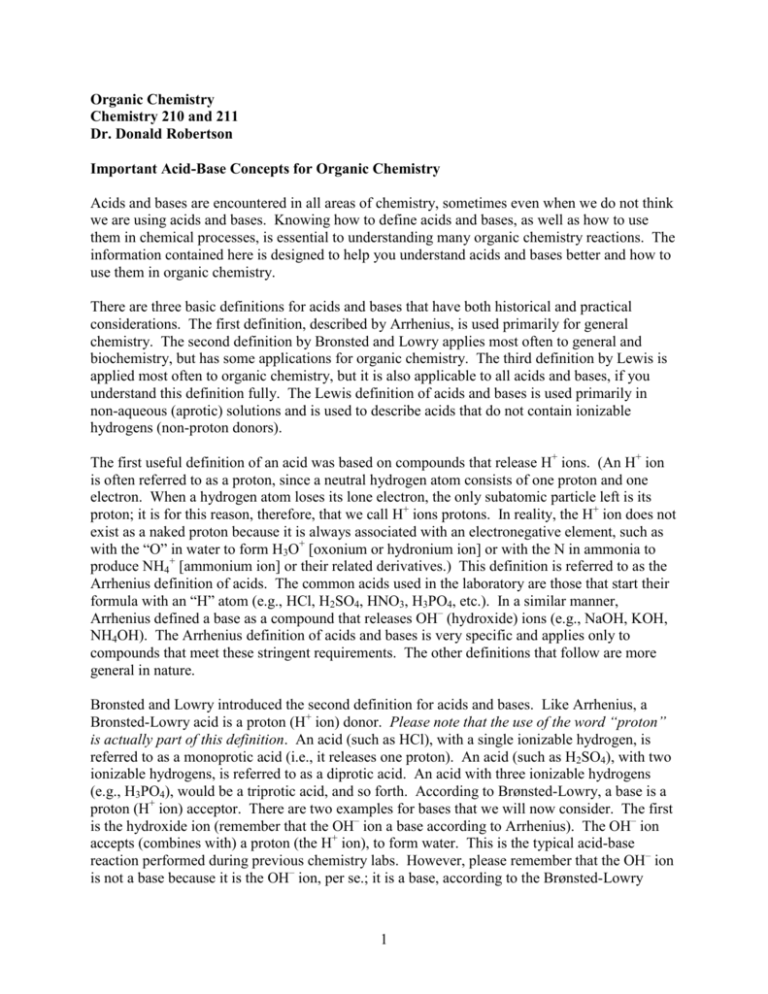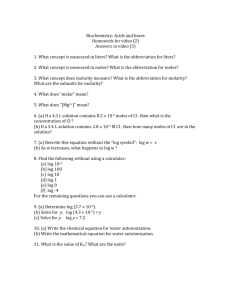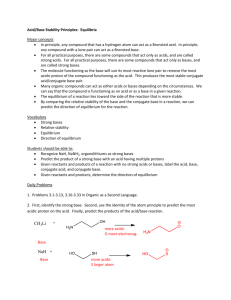Acid-base properties:
advertisement

Organic Chemistry Chemistry 210 and 211 Dr. Donald Robertson Important Acid-Base Concepts for Organic Chemistry Acids and bases are encountered in all areas of chemistry, sometimes even when we do not think we are using acids and bases. Knowing how to define acids and bases, as well as how to use them in chemical processes, is essential to understanding many organic chemistry reactions. The information contained here is designed to help you understand acids and bases better and how to use them in organic chemistry. There are three basic definitions for acids and bases that have both historical and practical considerations. The first definition, described by Arrhenius, is used primarily for general chemistry. The second definition by Bronsted and Lowry applies most often to general and biochemistry, but has some applications for organic chemistry. The third definition by Lewis is applied most often to organic chemistry, but it is also applicable to all acids and bases, if you understand this definition fully. The Lewis definition of acids and bases is used primarily in non-aqueous (aprotic) solutions and is used to describe acids that do not contain ionizable hydrogens (non-proton donors). The first useful definition of an acid was based on compounds that release H+ ions. (An H+ ion is often referred to as a proton, since a neutral hydrogen atom consists of one proton and one electron. When a hydrogen atom loses its lone electron, the only subatomic particle left is its proton; it is for this reason, therefore, that we call H+ ions protons. In reality, the H+ ion does not exist as a naked proton because it is always associated with an electronegative element, such as with the “O” in water to form H3O+ [oxonium or hydronium ion] or with the N in ammonia to produce NH4+ [ammonium ion] or their related derivatives.) This definition is referred to as the Arrhenius definition of acids. The common acids used in the laboratory are those that start their formula with an “H” atom (e.g., HCl, H2SO4, HNO3, H3PO4, etc.). In a similar manner, Arrhenius defined a base as a compound that releases OH– (hydroxide) ions (e.g., NaOH, KOH, NH4OH). The Arrhenius definition of acids and bases is very specific and applies only to compounds that meet these stringent requirements. The other definitions that follow are more general in nature. Bronsted and Lowry introduced the second definition for acids and bases. Like Arrhenius, a Bronsted-Lowry acid is a proton (H+ ion) donor. Please note that the use of the word “proton” is actually part of this definition. An acid (such as HCl), with a single ionizable hydrogen, is referred to as a monoprotic acid (i.e., it releases one proton). An acid (such as H2SO4), with two ionizable hydrogens, is referred to as a diprotic acid. An acid with three ionizable hydrogens (e.g., H3PO4), would be a triprotic acid, and so forth. According to Brønsted-Lowry, a base is a proton (H+ ion) acceptor. There are two examples for bases that we will now consider. The first is the hydroxide ion (remember that the OH– ion a base according to Arrhenius). The OH– ion accepts (combines with) a proton (the H+ ion), to form water. This is the typical acid-base reaction performed during previous chemistry labs. However, please remember that the OH– ion is not a base because it is the OH– ion, per se.; it is a base, according to the Brønsted-Lowry 1 definition, because it “accepts” a proton. The second example is that of ammonia (NH3). Ammonia is a base, not because it contains the OH- ion (which it obviously does not), but because it “accepts” a proton (H+ ion) to form the ammonium ion (NH4+). The hallmark of Brønsted-Lowry bases is that they must possess at least one lone pair of electrons (you must be able to draw correct Lewis dot structures), and both water and ammonia have lone electron pairs (can you draw their correct Lewis dot structures?). The third definition of an acid is that proposed by Lewis. These compounds are described as being Lewis acids or Lewis bases. You will eventually see that both the Arrhenius and Brønsted-Lowry definitions are consistent with those of Lewis, but you must be able to visualize correct Lewis dot structures. The Lewis definition of an acid is an electron pair acceptor (generally containing an atom with fewer than an octet of electrons; e.g., BH3, AlCl3, or a carbocation). You should be able to see that a proton (an H+ ion) meets this definition as well, since it can combine with a pair of electrons (e.g., donated by the OH– ion) to react with the OH– ion and form water. Conversely, a Lewis base is an electron pair donor (usually possessing an octet of electrons, but with at least one lone pair of electrons). So, how do you determine if you have a Lewis acid or base? You must be able to draw correct Lewis dot structures. What are pKa values, and how do you predict pKa values? The pKa is a term that we encounter for acids that release protons. Let’s take the example of HCl(aq). When HCl(g) dissolves in water, it breaks apart into two parts, the proton (H+ ion) and its conjugate base, the chloride ion (Cl-). A conjugate base is formed when an acid loses a single proton. A conjugate acid is formed when a conjugate base accepts a proton. The ionization equation for HCl(g) dissolving in water is shown below: HCl H+ + Cl– (HCl is the conjugate acid; Cl– is the conjugate base) Water also undergoes ionization according to the following equation: HOH H+ + OH– (HOH is the acid; OH– is the base) The Keq for the ionization of water (an acid) is then expressed as Ka: H OH K eq Ka HOH This equation is the same equation as any equilibrium constant (i.e., Keq is equal to the multiple of the concentrations of the products divided by the multiple of the concentrations of the reactants). For water, the concentration of H+ ions [H+] is 10-7 M, and the concentration of OH– ions [OH–] is also 10-7 M; the concentration of water [HOH] is 55.555 M. When the concentrations of the various components are factored into this equation, we get the following value for the Keq for water (you should note that since we are showing the equilibrium constant of an acid, we make Keq= Ka). 2 107 107 K eq 1.00018 x1016 K a 55.555 Since, by definition, the pKa value is the negative log of the Ka, we can now calculate the pKa of water: pKa log Ka 15.7 This is the pKa value that we have used previously, and it is something that you have probably should already memorized. Conjugate Acids and Conjugate Bases To determine the strength of an acid, the acid that has the smaller pKa value (less positive, or more negative) is the stronger acid. For example, an acid with a pKa of 1.0 is a stronger acid than an acid with a pKa of 5.5; an acid with a pKa of 15.7 is a stronger acid than an acid with pKa of 36, etc. A pKa value applies only to a compound or ion that has ionizable hydrogens (protons can be produced) on it. As a result, you need to identify compounds that have ionizable hydrogens. These include the common acids (HCl, HNO3, H2SO4, HC2H3O2; what are the names of these acids?). What about water, or ethanol, or ammonia; are these acids as well? As a consequence, a compound with an ionizable hydrogen is referred to as an acid (proton donor; the Bronsted-Lowry definition). The conjugate base of an acid is formed when one, and only one, hydrogen comes off as an H+ ion (a proton). Let’s now look at sulfuric acid, H2SO4. When you remove one proton (H+), you produce its conjugate base (hydrogen sulfate ion), as shown below: H2SO4 H+ + HSO4– (HSO4- is the conjugate base of H2SO4) Please note that the conjugate base of sulfuric acid is not the sulfate ion. The reason is that it requires the removal of two protons to produce the sulfate ion from sulfuric acid, and a conjugate base can differ by only one proton from the acid. The hydrogen sulfate ion (HSO4–) is actually the conjugate base of H2SO4. However, the hydrogen sulfate ion is also a conjugate acid, since it still has an ionizable hydrogen, which can be removed, as shown below: HSO4– H+ + SO42– (SO42– is the conjugate base of HSO4–) Remember, in order to obtain a conjugate base, you look at the appropriate conjugate acid and remove one (and only one) H+ ion from it. Be sure to remember that acid-base conjugate pairs differ by a single H+ ion. What is the formula for the conjugate base for each of the acids shown? What is the name of that conjugate base? HCl Conjugate base is ________ base name __________________________ 3 HOH Conjugate base is ________ base name __________________________ H3PO4 Conjugate base is ________ base name __________________________ H2CO3 Conjugate base is ________ base name __________________________ HCO3– Conjugate base is ________ base name __________________________ C2H5OH Conjugate base is ________ base name __________________________ Every acid, which has one or more ionizable hydrogens, has a conjugate base. Sometimes, the conjugate base may itself function as an acid (e.g., the hydrogen sulfate ion shown above), if it still has an ionizable hydrogen. Another example is the hydrogen carbonate ion (HCO3–), also shown above. Buffers, pH, and Henderson-Hasselbach Equation At some time during your exposure to chemistry, you will encounter buffers. A buffer is a combination of conjugate acid and conjugate base that resists a change in pH. What is pH? It is, mathematically speaking, a value equal to the negative log of the [H+] concentration: pH log[ H ] For example, if water has a [H+] concentration of 10–7 M, then the pH of water would be 7.0: pH log[ H ] log[107 ] 7.0 An aqueous solution is neutral when the pH is 7.0, meaning that the concentration of [H+] and of [OH-] both equal 10-7 M. That is, if you have equal concentrations of acid [H+] and base [OH-] in a solution, you are neither acidic nor basic, so as a result, the solution is considered to be neutral. Now how does a buffer work? Let’s assume we have the bicarbonate (hydrogen carbonate) ion: HCO3-. If you examine this ion carefully, you will see that it has an ionizable hydrogen, hence it is an acid. Likewise, the hydrogen carbonate ion can accept a proton, so it is also a base. Look at what happens when the hydrogen carbonate ion reacts with both acid [H+] and base [OH-]. You should remember that carbonic acid is not very stable, and under most conditions will readily break back down to CO2 and HOH. HCO3- + H+ H2CO3 (carbonic acid) HOH + CO2 (solution is neutral) HCO3- + OH- HOH + CO32- (solution is neutral) For a buffer, adding either acid or base does not appreciably change the pH (products are not strongly acidic or strongly basic). In order to have a buffer, you must have an acid-base conjugate pair in solution. 4 Predicting acid strength, or relative pKa values Within a column (Group) of the Periodic Table, the longer the bond (going down the Group) to the hydrogen atom, the easier it is to break that bond (e.g., HI is a stronger acid than is HCl; H2S [HSH] is a stronger acid than is H2O [HOH]). The easier it is to remove a proton [H+], the stronger the acid. Predict which of the following acid pairs would be most and least acidic: HF/HCl Most Acidic: ___________ Least Acidic: ___________ H2O/H2Se Most Acidic: ___________ Least Acidic: ___________ HBr/HI Most Acidic: ___________ Least Acidic: ___________ NH3/PH3 Most Acidic: ___________ Least Acidic: ___________ Within a row (Period) in the Periodic Table, the more polar the bond, the easier it is to pull the polarized H off its bonded atom (e.g., the HF bond is more polar [due to a greater difference in electronegativity] than a HOH bond; HF has a pKa of ~3, and HOH has a pKa of 15.7). Predict the order (from most acidic to least acidic) of the following compounds: HCH3 HOH HF HNH2 Most acidic: __________ > __________ > __________ > __________ Least acidic Remember that as far as pKa values go, the more acidic compound has the smaller pKa. Place each of the following acids in the order of increasing pKa values: HCl HF H2O NH3 HI Smallest pKa ________ < ________ < ________ < ________ < ________Largest pKa (Most acidic) (Least acidic) Now that we have learned how to predict relative acid strength for different compounds, let’s look at what is left, that is the conjugate base. Please remember that the ease in forming something is related to how stable the resulting product will be. Let’s look at some examples that we have already discussed in organic chemistry. Which compound in each of the following pairs of compounds would be the strongest and weakest acid? Read the next paragraph to get more information on doing these comparisons. Ethanol/acetic acid Most Acidic: ____________ Least Acidic: ___________ Ethanol/water Most Acidic: ___________ 5 Least Acidic: ___________ Acetic/fluoroacetic acid Most Acidic: ___________ Least Acidic: ___________ Methanol/phenol Most Acidic: ___________ Least Acidic: ___________ The reason acetic acid is a stronger acid than ethanol is because of the stability of what is left behind: “The ease of formation is related to how stable what’s left behind is going to be.” That is, the negative charge left on the oxygen atom for the ethoxide ion (can you write the formula of this ion?) has no place to go (you cannot disperse the charge via resonance). However, for the acetate ion, the negative charge can resonate between the two oxygen atoms. Can you draw these resonance structures? As a general rule, the easier it is to disperse the charge, the more stable that ion (or compound) will be. It is for this reason that the acetate ion is easier to form than is the ethoxide ion. Since the acetate ion is easier to form, acetic acid is a stronger acid than is ethanol (because the resulting anion is more stable). Therefore, you should be able to predict the relative pKa values for these compounds (even though you may not know the exact pKa). In fact, the pKa for ethanol is 16.0 and the pKa for acetic acid is about 5.0, meaning that acetic acid is eleven orders of magnitude stronger acid than is ethanol. If you can predict relative pKa values, then you also have the ability to predict the relative strengths of the resulting conjugate bases. The rule you need to remember is that the stronger the acid, the weaker its conjugate base. This is actually pretty intuitive. Think of it as follows. A strong acid is a compound that does not want to hold on to the H+ ion very strongly. That is because the conjugate base is not very strong. Remember, a strong base wants to hang on to the proton longer, and if you hang on to the proton longer, you are a weaker acid. So, a strong acid has a weak conjugate base. Likewise, a weak acid has a strong conjugate base, because the conjugate base does not want to let go of the proton (hence, it is a weak acid). Try to remember these relationships: a strong acid has a weak conjugate base, and a weak acid has a strong conjugate base. Now, let’s look at some of the acids we have already looked at (we have already done this problem above). For each of the following acids, place them in the correct order: HCl HF H2O NH3 HI Smallest pKa ________ < ________ < ________ < ________ < ________Largest pKa (Most acidic) (Least acidic) Now, look at the following conjugate bases of the acids listed above: Cl- F- OH- NH2- I- List each of these conjugate bases in order of increasing basicity (base strength): Least basic ________ < ________ < ________ < ________ < ________ Most basic 6 The solution is based on their relationship to acid strength. Remember that the strongest acid will have the least basic conjugate base. Let’s do this exercise with some other compounds, which we have already examined for relative acid strength above: Predict the order (from most acidic to least acidic) of the following: HCH3 HOH HF HNH2 Most acidic: __________ > __________ > __________ > __________ Least acidic Now, that you have ordered these compounds from most acidic (smallest pKa) to least acidic (largest pKa), how would you rank their conjugate bases? CH3- OH- F- NH2- Strongest base: __________ > __________ > __________ > __________ weakest base How did you do? Remember that the strongest conjugate base comes from the weakest conjugate acid. Nucleophiles and electrophiles Organic chemistry is routinely broken down into acid-base reactions. Nucleophiles are nucleusloving chemical species, meaning that a nucleophile is looking for an atom that is electron deficient (electrophile). For the most part, the electrophile is the acid, and the nucleophile is the base. According to the Lewis definition of acids and bases, a base (nucleophile) is an electron pair donor and a Lewis acid (electrophile) is an electron pair acceptor. Carbon atoms have been both electrophiles (e.g., carbocations and carbon atoms in SN1 or SN2 reactions). When we got to aromatic compounds, the carbon atoms functioned as nucleophiles, because the carbons in the aromatic ring structure had electrons available to them. However, no matter which class of carbon compounds you are working with, you will always need to identify what is the nucleophile and what is the electrophile for a particular reaction. This is not always easy, but there are a few clues. For example, when a carbon atom is bonded to an electronegative atom, such as F, O, or N, that carbon will almost always be considered to be an electrophilic carbon. Therefore, it now becomes necessary to identify the compound or ion that is the nucleophile. A nucleophile will always have a free pair of electrons available on one of its atoms. This might take a little practice, but it will soon become obvious and easy to identify which compound or ion is the nucleophile and which compound or ion is the electrophile. Once you identify the nucleophile, all you need to do to get the reaction is to draw an arrow from the pair of electrons on the nucleophile to the electrophilic atom. Most of the time, a carbon atom will be the electrophile. Let’s just assume right now that it will be a carbon atom, and we need to identify which carbon will be the electrophilic carbon. Based on what we have learned before, any carbon attached to an O, N, or halogen (F, Cl, Br, I) will be 7 the electrophile since it will have acquired a partial positive charge (+), due to differences in electronegativity. These compounds are rather easy to identify and were encountered during substitution reactions. We will soon work with other types of carbon-containing compounds. The most common organic compounds that we will encounter will be those with carbonyl groups, which include the aldehydes, ketones, carboxylic acids, and the carboxylic acid derivatives such as esters, amides, acid anhydrides, and acid chlorides. The structures of these compounds will be examined later. However, what you need to know and look for in these compounds is that they all contain carbon atoms bonded to the electronegative element O. Because of the differences in electronegativity, the carbon atoms acquire a partial positive charge (+), and are electrophilic. Do you understand this concept? Now, since you have learned to identify the probable electrophile, you will need to know how to identify the probable nucleophile. In the past, the nucleophile was something like a halide (e.g., Br-, Cl- or I-) or the OH- ion. In addition, we also used the OH group of an alcohol as a nucleophile. In the future you will also need to identify certain carbon atoms that will function as a nucleophile (a carbon atom possessing an unbonded lone pair of electrons is referred to as a carbanion). We can wait until later to discuss these carbon nucleophiles, but the key concept is that we need to have a nucleophile and an electrophile for virtually every organic chemistry reaction we will be using. Acids and bases, as electrophiles and nucleophiles, respectively, are encountered in virtually every organic chemistry reaction. Your success in organic chemistry will be directly proportional to your understand of these concepts. Do not take them lightly, or you will struggle in the course. If you learn to understand these concepts, you will excel, not because you have memorized everything but because you have learned to think your way through the process. Try to look for unifying principles, and you will understand organic chemistry better than you ever imagined. Good luck. 8





